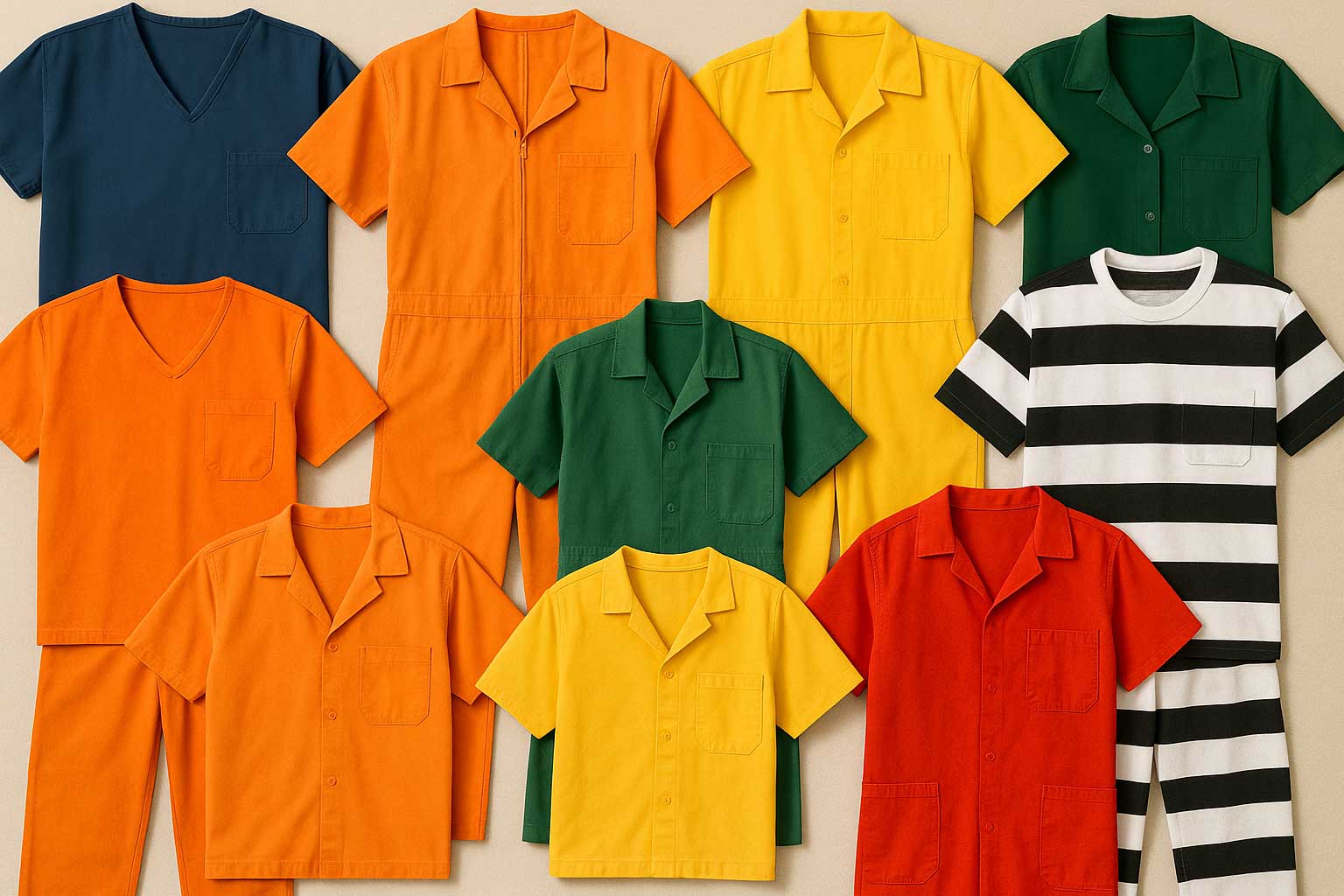Uniforms in corrections are never just about fabric. They are visual codes, psychological markers, and logistical puzzles, stitched together in polyester and cotton blends. They tell officers who they’re dealing with at a glance. They broadcast status and privilege, or the lack of it. And sometimes, as in Newton County, Texas, they get a makeover to solve a very specific problem: how to make sure everyone knows who’s a trustee and who’s a high-level offender.
This summer, Newton County jail swapped out trustee uniforms for a new black and white design. The reason was simple enough. Jail leaders wanted a sharper distinction between inmates granted trustee status—those who have earned extra responsibility or trust through good behavior—and those considered higher risk. The change might sound small, just a shift in color palette, but in the world of corrections it is part of a much larger conversation about what uniforms mean, what they do, and how they evolve over time.
The Semiotics of Color Behind Bars
Corrections facilities live and die by visual cues. A glance across a yard or hallway has to communicate information instantly. That is why colors are so powerful. An orange jumpsuit isn’t just fabric; it is a symbol burned into the cultural imagination. Movies, TV, and news footage have turned orange into shorthand for “inmate.” But inside actual facilities, orange may not mean what the public thinks it means. In many jails, orange is only one of several colors in use.
Facilities frequently use an entire spectrum of hues to mark security levels, mental health status, or work assignments. Yellow might mean someone is on an outside work crew. Green could denote mental health monitoring. Red might be segregation or high-risk. Blue or khaki could be standard issue for medium security. The colors shift from one county to another, but the logic is the same: uniforms are a fast, visible language of order.
That brings us back to Newton County. By choosing black and white stripes for trustees, the jail was not indulging in nostalgia for old Western chain gang imagery. Instead, they were deliberately reaching for contrast. Trustees need to be identifiable from across a room or a courthouse corridor. They often interact more with staff and the public, whether they are cleaning, delivering meals, or assisting with daily operations. The more they stand out, the less likely they are to be confused with higher-risk inmates. Color becomes both a safety measure and a management tool.
From Stripes to Solids to Scrubs
Uniform design in corrections has always bounced between function, symbolism, and public image. The black-and-white stripes familiar from cartoons and silent films were never universal, but they did dominate much of the early 20th century in the United States. They were chosen precisely because they were bold and unmistakable. Stripes screamed “prisoner.” They also made escapees easier to spot. But they carried an obvious downside: humiliation. As ideas of prison reform shifted toward dignity and rehabilitation, stripes gave way to solids.
By the 1970s and 80s, many facilities had adopted solid jumpsuits in orange, blue, or green. These were easier to mass produce, easier to launder, and less stigmatizing than stripes. They also fit better with the growing push to view inmates as people who could one day reenter society, not just faceless convicts. Yet uniforms never stopped carrying layers of meaning. The choice of color still told staff—and anyone on the outside—exactly who they were looking at.
Today, the trend leans toward what could be called the “medicalization” of inmate attire: scrubs-style tops and pants. They are cheap, practical, and easy to size. They can be mixed and matched with color codes to handle multiple inmate categories at once. They also signal a shift in thinking. Scrubs look less like punishment gear and more like work or patient clothing, echoing modern correctional philosophies that try, at least in theory, to emphasize rehabilitation. But the balance is delicate. A facility that dresses its inmates too much like hospital patients risks blurring lines of authority, while one that clings to the old stripes risks accusations of degradation.
Corrections Officers and the Parallel Story
While inmates have seen their uniforms evolve for symbolic and logistical reasons, corrections officers themselves have also been part of the uniform story. Their attire has shifted from purely paramilitary looks—starched shirts, ties, and heavy belts—toward more functional blends that acknowledge the reality of the job. In some states, gray and black combinations are replacing the traditional blues, and clip-on ties have been dropped in favor of safer, cleaner designs. The fabrics now emphasize durability, stretch, and stain resistance, because officers need gear that performs under stress.
This parallel evolution matters for manufacturers and distributors. Supplying correctional institutions isn’t just about keeping inmate uniforms in stock; it’s also about equipping officers with clothing that projects professionalism while standing up to the grind of the work. Both sides of the correctional uniform equation—staff and inmate—are under pressure to evolve, and that means opportunity for companies that can handle complex orders with varied specifications.
What’s Driving the New Wave of Changes
Several forces are pushing corrections uniforms into new territory. The first is simple operational necessity. Facilities want uniforms that are easy to launder, hard to alter, and quick to replace. Every color change or style shift is also about inventory management. When a jail switches to black and white trustee garb, it must reorder stock, phase out the old, and train staff on the new system. That has ripple effects for distributors and manufacturers, who need to supply smaller, specialized lots on demand.
Another driver is safety. Uniforms are being adapted to reduce risks, whether through high-visibility colors for outside work crews or fabrics that resist tearing and tampering. In some cases, facilities have considered adding reflective strips or patches to reduce the chance of mistaken identity when trustees are outside near roads or working in public spaces.
Public perception plays its role as well. High-profile incidents of mistaken identity or inmate escape can push agencies to rethink uniform systems overnight. Uniforms that are too close to civilian clothing can backfire, while those seen as overly punitive can invite criticism from civil rights advocates. The sweet spot lies somewhere between functionality, security, and the optics of fairness.
Finally, policy changes and legal standards shape what’s acceptable. International guidelines like the Mandela Rules discourage degrading or humiliating attire. This doesn’t mean a U.S. county jail is bound by them, but it does mean that oversight bodies, advocacy groups, and even juries can look askance at uniforms that seem designed to shame. In that climate, a striped trustee uniform may be seen differently in Newton County than it would in New York City, where the cultural baggage of stripes still looms large.
Where It All Goes from Here
The future of corrections uniforms will likely be defined by flexibility. Counties and states will continue to juggle multiple uniform systems—scrubs for one group, jumpsuits for another, high-visibility gear for those on outside detail, and distinct trustee colors for yet another category. Manufacturers who can supply this variety efficiently, while keeping costs in check, will have an advantage.
There is also room for innovation. Performance fabrics with antimicrobial treatments, odor control, and stretch panels could become standard, not just for officers but for inmates too. Digital identification patches, smart fabrics, or barcoded designs might one day replace or supplement color codes, making it easier for facilities to manage populations and track uniforms in real time.
But for now, corrections uniforms remain one of the clearest examples of how clothing is never just clothing. Behind the fences and walls, a black stripe or an orange jumpsuit tells a story of security, authority, and trust. Newton County’s trustees now wear black and white because their leaders wanted clarity, safety, and recognition. Across the country, other facilities are making similar decisions, each one a reminder that in corrections, uniforms are part of the language of order itself.
To Read More
“Newton County crime sweep leads to arrests, uniform changes” – Beaumont Enterprise
https://www.beaumontenterprise.com/jasper/article/newton-county-crime-sweep-leads-arrests-20390433.php
“Prison Uniform” – Wikipedia
https://en.wikipedia.org/wiki/Prison_uniform
“County Jail Jumpsuit Multi-Color Flyer” – Indiana Correctional Industries
https://www.in.gov/idoc/indianacorrectionalindustries/files/County-Jail-Jumpsuit-Multi-Color-flyer-11.21.pdf
“Spring to bring new style for NC prisons” – Corrections1
https://www.corrections1.com/corrections/articles/spring-to-bring-new-style-for-nc-prisons-3Of9hGUB9giWKwc8/
“Prison Uniforms: A Survey of Symbolism and Use in the U.S.” – ScholarWorks, Indiana University
https://scholarworks.iu.edu/dspace/bitstreams/f281cdf3-3a46-4d16-9a8d-814b5c33a9db/download
“Custody Division Manual – Uniforms” – Los Angeles County Sheriff’s Department
https://pars.lasd.org/Viewer/Manuals/12547/Content/14085




















